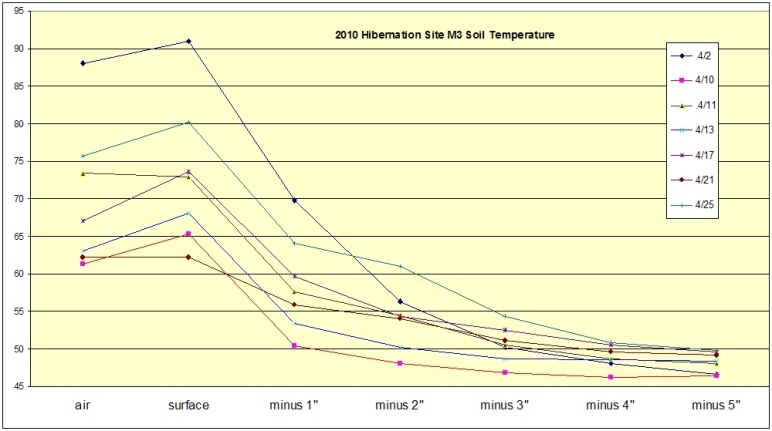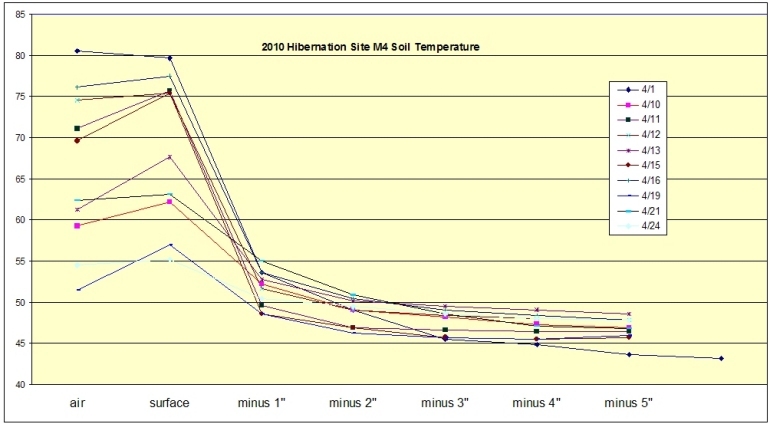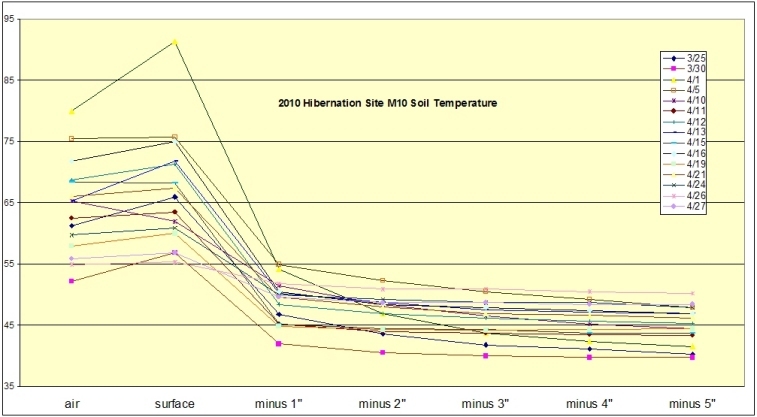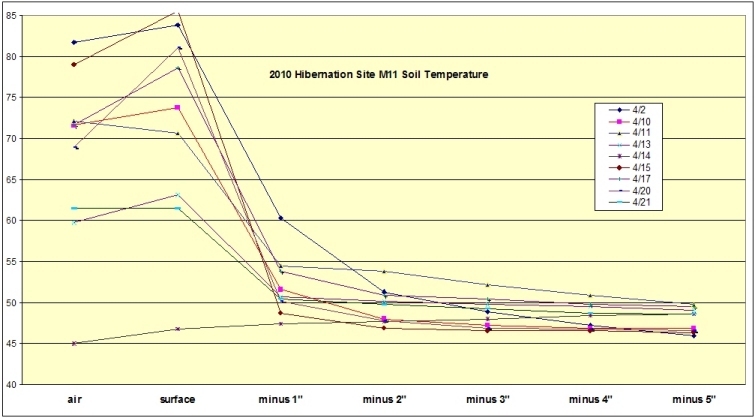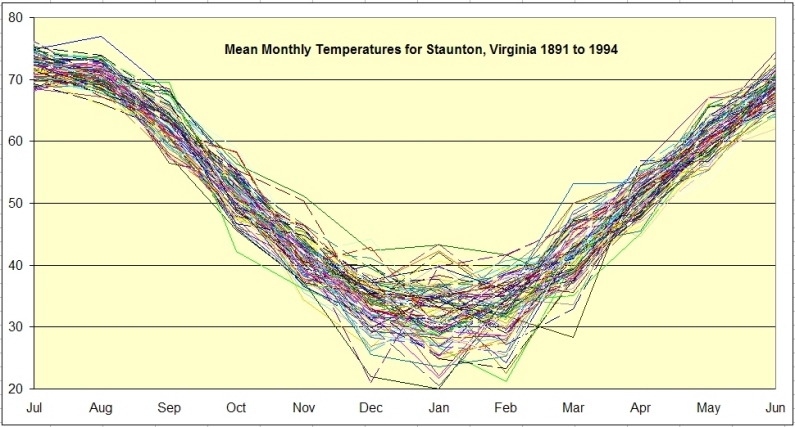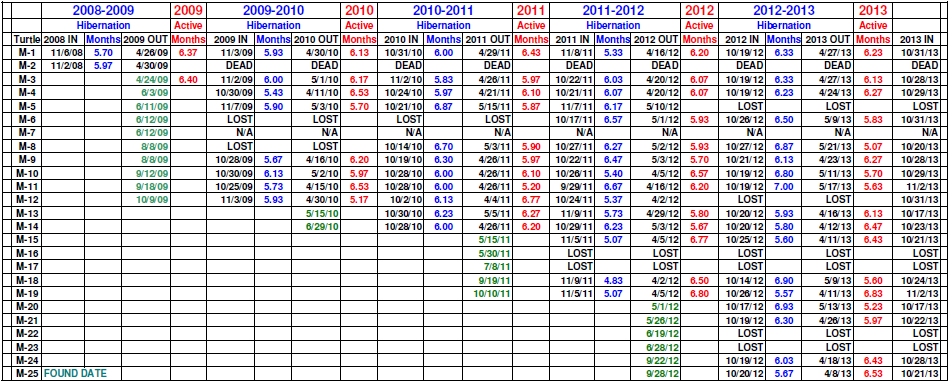Temperature may be a factor triggering hibernation, but likely also are day length, sun elevation, food scarcity, and even leaf fall. Some turtle hibernation dates are so close year-to-year that is seems the turtle is depending on a biological clock (or calendar).
These turtles reduce their travels and begin hibernation behavior soon after the first leaves fall. Eastern Box turtles stop eating and empty their bowls. After selecting a site, a turtle will work it's way into a burrow that is open to the weather until falling leaves cover and insulate the hole's entrance. Soon, rains soften and compress the leaves into wet "books" effectively sealing the entrance from outside winter temperatures. Additional leaf litter and snow cover further insulate the turtle from sub-freezing temperatures.
The preferred hibernation sites in this study area are usually associated with pine trees. The soils under pines are well drained, airy, and acidic. Little understory grows under pines, reducing occurrence of large tangled roots. The roots of pines are small and grow in many horizontal layers allowing a turtle to work it's way between these layers with relative ease. These soils remain moist throughout the winter until emergence.
Many of the best hibernation sites are in "stump holes"; depressions created when a tree is blown over by wind and the root ball is up-ended out of the soil. These stump holes can be deep and as they collect leaf litter over the years, they become easy to work into, are very well insulated, well drained, and retain moisture throughout the winter. Many stump hole hibernation sites are re-used year after year by the same individual.
Stump holes of even small trees, often survive well past the complete disintegration of the fallen tree and roots.
Hibernation and Emergence Dates and Activity and Hibernation Duration.
93 and 103 year average monthly temperature history for nearby Lexington and Stanton, Virginia respectively, Both are lower elevation than the turtle study site, but the charts demonstate the variability of winter temperatures compared to spring, summer and fall temperatures in this part of the country.
Pre-emergence Soil Temperatures
Historic Winter Temperatures
Air, Surface and Subsurface Temperature Changes for the Month Prior to Emergence. Collected April 2010
Between 4/2/10 and 4/25/10, soil temperatures at the 5" depth rose 3.4 degrees F. The M3 site is located at the ROW/forest edge. Emergence date was 5/1/10.
At the M4 site, soil temperatures at the 5 inch depth rose 4.9 degrees F between 4/1/10 and 4/24/10. This site is in the woods in a stand of pines. Emergence date was 4/11/10.
M5 site. From 4/10/10 to 4/27/10, soil temperatures at the 5 inch depth rose 4.5 degrees F. Emergce date was 5/3/10.
At the M9 site, soil temperatures rose 10.0 degrees F. from 3/24/10 to 4/ 25/10. This site was located close to the road in the woods with light winter cover. Emergence date was 4/16/10.
This chart uses the exact same data as the one above.
Located at the forest edge, unsheltered, near the road, this site received direct sunlight part of most days. There was a 3.8 degree F. temperature rise between 4/2/10 and 4/21/10. Emergence date was 4/15/10.
At the M10 site, the soil temperature at the 5 inch depth rose 10.5 degrees F. between 3/25/10 and 4/27/10. The emergence date was 5/2/10.
The last two weeks in October is generally when most of these turtles go underground.
Recording the air temperatures in the weeks prior would tend to indicate the trend to come, which maybe provides the signal the turtle needs.
Brumation vs Hibernation
Box turtles are ectothermic (cold-blooded) animals, relying on their environment for thermoregulation. Dormancy is the strategy they use to ensure survival when environmental conditions become very cold. Box turtles brumate, (a term that can be loosely equated to hibernation among mammals), typically finding hibernaculums within their environment in which they can be somewhat insulated, and become lethargic and inactive.
Technically, Box turtles don't hibernate, (only mammals hibernate), but this is the term which is most often used when discussing their period of cold weather dormancy. To be consistent, "hibernation" will be the term used throughout this web site when discussing brumation.
Although Box turtles can survive sub-freezing temperatures without any apparent harm, most hibernation sites provide enough insulation protection that even during sub-zero air temperatures, a turtle experiences temperature lows, usually above 35 degrees or so.
Turtle M6, an old active female, uses the exact same stump hole for hibernation every year and even though she travels very long distances during the summer season to nest in an open meadow, she travels back to this hibernation location every fall.
These hibernation site temperature charts show actual 4-hour recorded temperatures of air and soil, as well as the temperature the turtle is experiencing, and recorded by a tiny iButton logger attached to the lower part of the carapace.
The high temperature spikes pre and post hibernation are the result of sunlight directly hitting the iButton's stainless steel case, and are NOT air temperatures. iButtons are able to help determine exactly when the turtle emerged, but are never adequate for recording air temperatures above ground.
Eastern Box Turtle
Terrapene carolina carolina
A Relict Population Doomed To Extinction?
